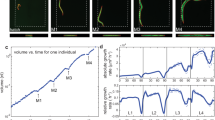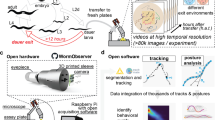Abstract
Mechanical vibration is a key external stimulus of living organisms. In previous studies, mechanical vibration has been found to affect the proliferation and differentiation of cells. However, there have been few reports of similar effects at the organismal scale. In this study, we demonstrated the effect of mechanical vibration on the growth and activity of Caenorhabditis elegans in the embryonic stage. The group of worms that were exposed to mechanical vibration during the embryonic period grew faster than the control group of worms. The growth of all groups was compared by measuring body length. Furthermore, we investigated the mechanical vibration effects in two types of mutants: body wall mechanosensory-abnormal mutants (mec-4(e1339)) and head mechanosensory-defective mutants (trp-4(sy695)). The mec-4(e1339) mutant was not affected by mechanical vibration during growth. On the other hand, the trp-4(sy695) mutant exposed to mechanical vibration showed a difference in growth compared with the control group, similar to wild-type worms. Therefore, mechanical vibration during the early developmental period of C. elegans affects the growth and activity of worms. Additionally, we observed a relationship between the gastrulation period and the mechanosensory system development of the worms. This study will serve as the basis for analyzing the effects of mechanical vibration on the developmental stages of C. elegans.
Similar content being viewed by others
References
Oh, E. S., Y. K. Seo, H. H. Yoon, H. Cho, M. Y. Yoon, and J. K. Park (2011) Effects of sub-sonic vibration on the proliferation and maturation of 3T3-L1 cells. Life Sci. 88: 169–177.
Ota, T., M. Chiba, and H. Hayashi (2016) Vibrational stimulation induces osteoblast differentiation and the upregulation of osteogenic gene expression in vitro. Cytotechnology. 68: 2287–2299.
Zhang, C., J. Li, L. Zhang, Y. Zhou, W. Hou, H. Quan, X. Li, Y. Chen, and H. Yu (2012) Effects of mechanical vibration on proliferation and osteogenic differentiation of human periodontal ligament stem cells. Arch. Oral Biol. 57: 1395–1407.
Kanie, K., T. Sakai, Y. Imai, K. Yoshida, A. Sugimoto, H. Makino, H. Kubo, and R. Kato (2019) Effect of mechanical vibration stress in cell culture on human induced pluripotent stem cells. Regen. Ther. 12: 27–35.
Marędziak, M., D. Lewandowski, K. A. Tomaszewski, K. Kubiak, and K. Marycz (2017) The effect of low-magnitude low-frequency vibrations (LMLF) on osteogenic differentiation potential of human adipose derived mesenchymal stem cells. Cell Mol. Bioeng. 10: 549–562.
Vandenberg, L. N., B. W. Pennarola, and M. Levin (2011) Low frequency vibrations disrupt left-right patterning in the Xenopus embryo. PLoS One. 6: e23306.
Vandenberg, L. N., C. Stevenson, and M. Levin (2012) Low frequency vibrations induce malformations in two aquatic species in a frequency-, waveform-, and direction-specific manner. PLoS One. 7: e51473.
Kaletta, T. and M. O. Hengartner (2006) Finding function in novel targets: C. elegans as a model organism. Nat. Rev. Drug Discov. 5: 387–398.
Korta, J., D. A. Clark, C. V. Gabel, L. Mahadevan, and A. D. Samuel (2007) Mechanosensation and mechanical load modulate the locomotory gait of swimming C-elegans. J. Exp. Biol. 210: 2383–2389.
Baek, J. H., P. Cosman, Z. Feng, J. Silver, and W. R. Schafer (2002) Using machine vision to analyze and classify Caenorhabditis elegans behavioral phenotypes quantitatively. J. Neurosci. Methods. 118: 9–21.
Rezai, P., A. Siddiqui, P. R. Selvaganapathy, and B. P. Gupta (2010) Electrotaxis of Caenorhabditis elegans in a microfluidic environment. Lab. Chip. 10: 220–226.
Wang, Z., I. Lee, T. J. Jeon, and S. M. Kim (2014) Micro-/nanofluidic device for tunable generation of a concentration gradient: Application to Caenorhabditis elegans chemotaxis. Anal. Bioanal. Chem. 406: 2679–2686.
The C. elegans Sequencing Consortium (1998) Genome sequence of the nematode C. elegans: A platform for investigating biology. Science. 282: 2012–2018.
Girard, L. R., T. J. Fiedler, T. W. Harris, F. Carvalho, I. Antoshechkin, M. Han, P. W. Sternberg, L. D. Stein, and M. Chalfie (2007) WormBook: The online review of Caenorhabditis elegans biology. Nucleic Acids Res. 35: D472–D475.
Markaki, M. and N. Tavernarakis (2010) Modeling human diseases in Caenorhabditis elegans. Biotechnol. J. 5: 1261–1276.
Engleman, E. A., S. N. Katner, and B. S. Neal-Beliveau (2016) Caenorhabditis elegans as a model to study the molecular and genetic mechanisms of drug addiction. Prog. Mol. Biol. Transl. Sci. 137: 229–252.
Bessa, C., P. Maciel, and A. J. Rodrigues (2013) Using C. Elegans to decipher the cellular and molecular mechanisms underlying neurodevelopmental disorders. Mol. Neurobiol. 48: 465–489.
Sugi, T., E. Okumura, K. Kiso, and R. Igarashi (2016) Nanoscale mechanical stimulation method for quantifying C. elegans mechanosensory behavior and memory. Anal. Sci. 32: 1159–1164.
Holbrook, R. I. and B. Mortimer (2018) Vibration sensitivity found in Caenorhabditis elegans. J. Exp. Biol. 221: jeb178947.
Teo, E., K. C. Batchu, D. Barardo, L. Xiao, A. Cazenave-Gassiot, N. Tolwinski, M. Wenk, B. Halliwell, and J. Gruber (2018) A novel vibration-induced exercise paradigm improves fitness and lipid metabolism of Caenorhabditis elegans. Sci. Rep. 8: 9420.
O’Hagan, R., M. Chalfie, and M. B. Goodman (2005) The MEC-4 DEG/ENaC channel of Caenorhabditis elegans touch receptor neurons transduces mechanical signals. Nat. Neurosci. 8: 43–50.
Kwon, N., A. B. Hwang, Y. J. You, S. J. V. Lee, and J. H. Je (2015) Dissection of C. elegans behavioral genetics in 3-D environments. Sci. Rep. 5: 9564.
Li, W., Z. Feng, P. W. Sternberg, and X. Z. S. Xu (2006) A C. elegans stretch receptor neuron revealed by a mechanosensitive TRP channel homologue. Nature. 440: 684–687.
Wang, Z., T. Han, T. J. Jeon, S. Park, and S. M. Kim (2013) Rapid detection and quantification of bacteria using an integrated micro/nanofluidic device. Sens Actuators B Chem. 178: 683–688.
Dong, L., R. Jankele, M. Cornaglia, T. Lehnert, P. Gönczy, and M. A. M. Gijs (2018) Integrated microfluidic device for drug studies of early C. elegans embryogenesis. Adv. Sci. 5: 1700751.
Nance, J., J. Y. Lee, and B. Goldstein (2005) Gastrulation in C. elegans. WormBook. http://www.wormbook.org.
Lee, J. Y. and B. Goldstein (2003) Mechanisms of cell positioning during C. elegans gastrulation. Development. 130: 307–320.
Fickentscher, R., P. Struntz, and M. Weiss (2013) Mechanical cues in the early embryogenesis of Caenorhabditis elegans. Biophys. J. 105: 1805–1811.
Rohrschneider, M. R. and J. Nance (2009) Polarity and cell fate specification in the control of Caenorhabditis elegans gastrulation. Devl. Dyn. 238: 789–796.
Acknowledgements
This work was supported by INHA UNIVERSITY Research Grant.
The authors declare no conflict of interest.
Neither ethical approval nor informed consent was required for this study.
Author information
Authors and Affiliations
Corresponding authors
Additional information
Publisher’s Note Springer Nature remains neutral with regard to jurisdictional claims in published maps and institutional affiliations.
Rights and permissions
About this article
Cite this article
Yoon, S., Ju, J., Kwon, S. et al. Growth and Activity of Caenorhabditis elegans Exposed to Mechanical Vibration During the Embryonic Period. Biotechnol Bioproc E 25, 126–131 (2020). https://doi.org/10.1007/s12257-019-0433-7
Received:
Revised:
Accepted:
Published:
Issue Date:
DOI: https://doi.org/10.1007/s12257-019-0433-7




